Unilever's Organizational Culture: Singapore and Australia Comparison
VerifiedAdded on 2021/04/21
|11
|2366
|96
Report
AI Summary
This report provides a comparative analysis of the organizational cultures within Unilever, specifically focusing on the differences between Singapore and Australia. It examines various aspects, including workplace layout, bureaucracy, working hours, individual behavior, and social interactions, to highlight the impact of cultural nuances. The report delves into how national cultures influence office design, communication styles, and employee interactions, referencing organizational communication theories to explain these differences. Key findings include variations in work hours, dress codes, hierarchical structures, and approaches to socializing and food sharing among employees. The study emphasizes the importance of understanding these cultural differences for effective management and cross-cultural collaboration within the multinational corporation. The analysis underscores the significance of adapting organizational practices to align with the unique cultural contexts of each location, thus fostering a more cohesive and productive work environment. You can find similar reports and solutions on Desklib.
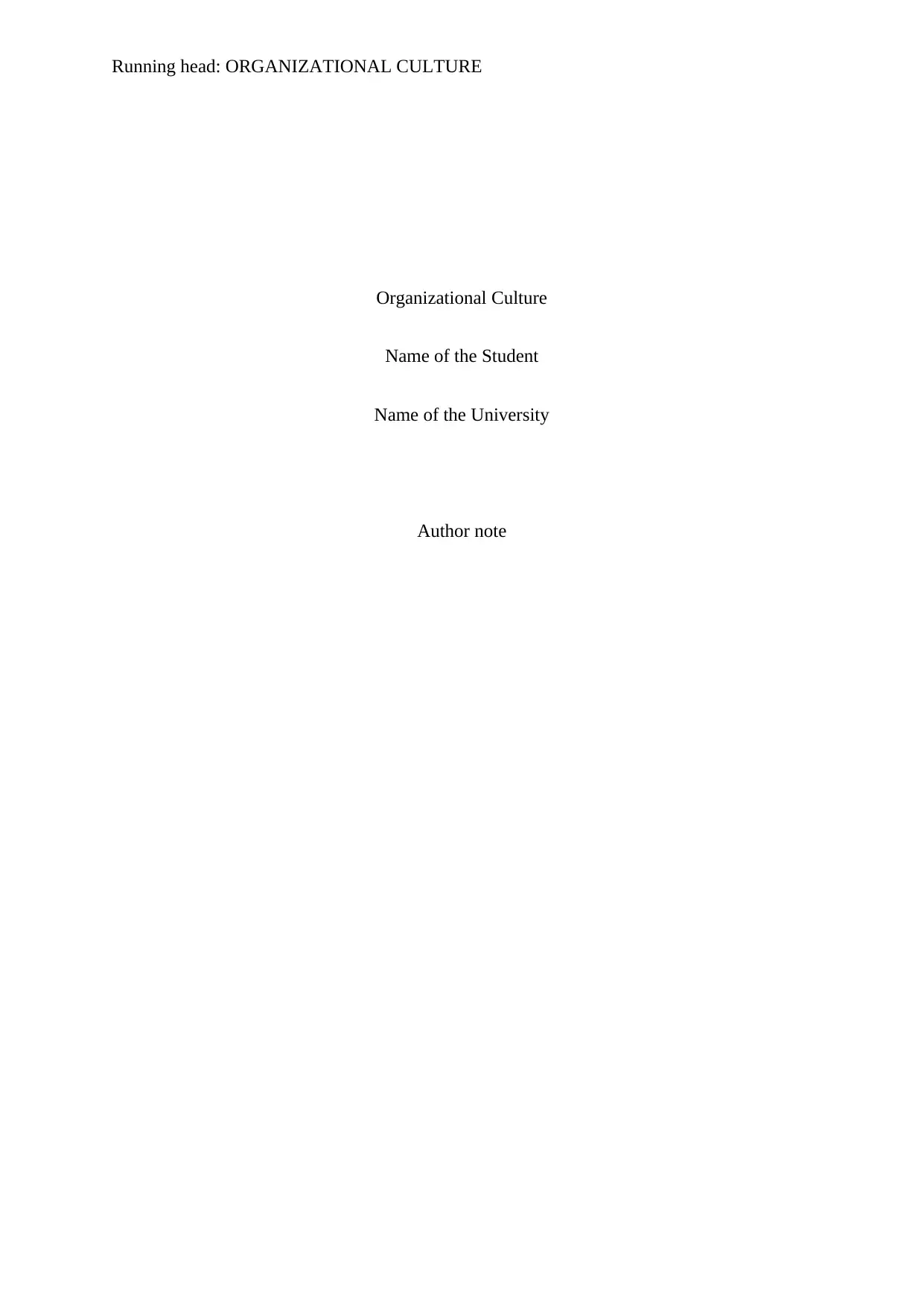
Running head: ORGANIZATIONAL CULTURE
Organizational Culture
Name of the Student
Name of the University
Author note
Organizational Culture
Name of the Student
Name of the University
Author note
Paraphrase This Document
Need a fresh take? Get an instant paraphrase of this document with our AI Paraphraser
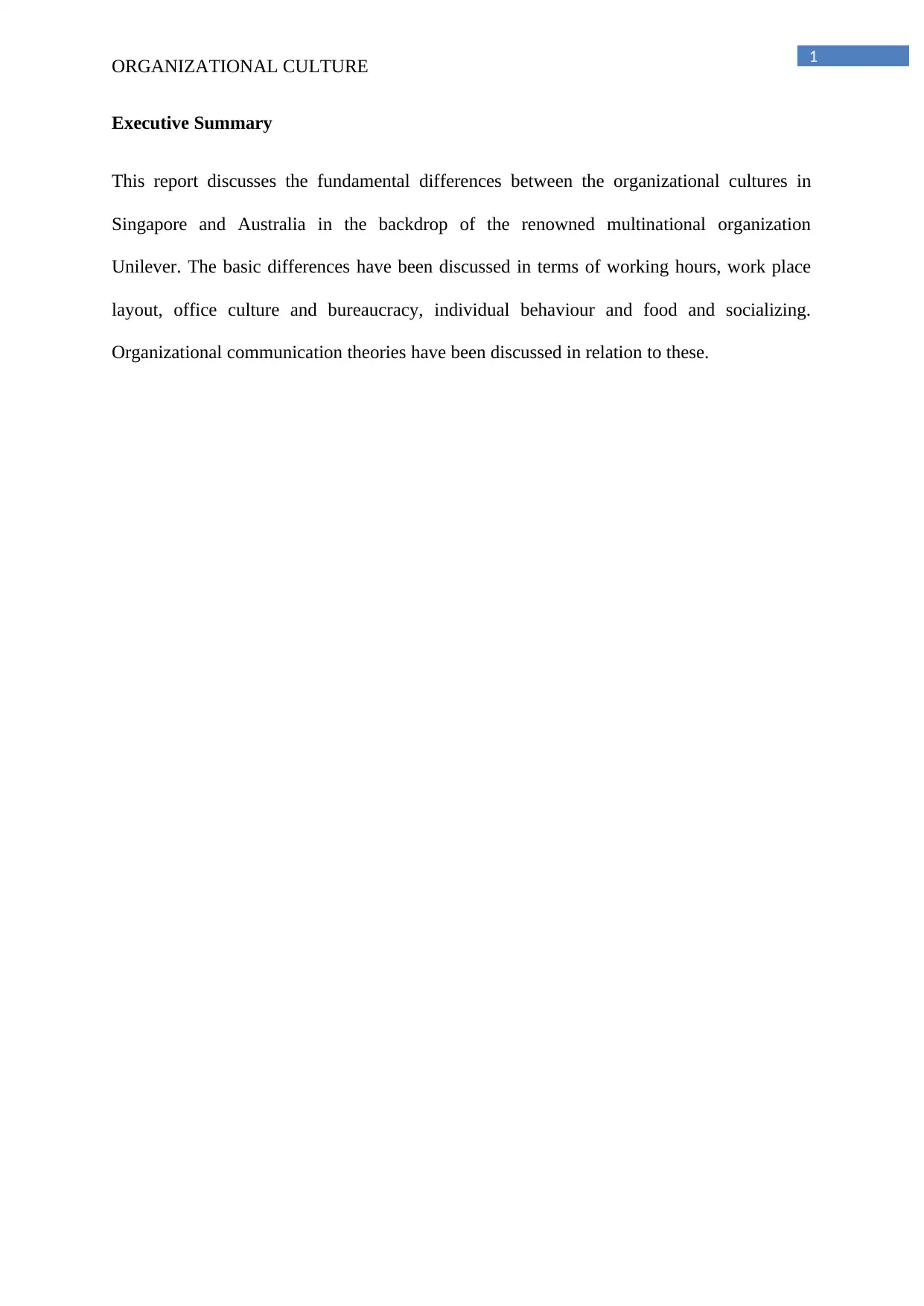
1
ORGANIZATIONAL CULTURE
Executive Summary
This report discusses the fundamental differences between the organizational cultures in
Singapore and Australia in the backdrop of the renowned multinational organization
Unilever. The basic differences have been discussed in terms of working hours, work place
layout, office culture and bureaucracy, individual behaviour and food and socializing.
Organizational communication theories have been discussed in relation to these.
ORGANIZATIONAL CULTURE
Executive Summary
This report discusses the fundamental differences between the organizational cultures in
Singapore and Australia in the backdrop of the renowned multinational organization
Unilever. The basic differences have been discussed in terms of working hours, work place
layout, office culture and bureaucracy, individual behaviour and food and socializing.
Organizational communication theories have been discussed in relation to these.
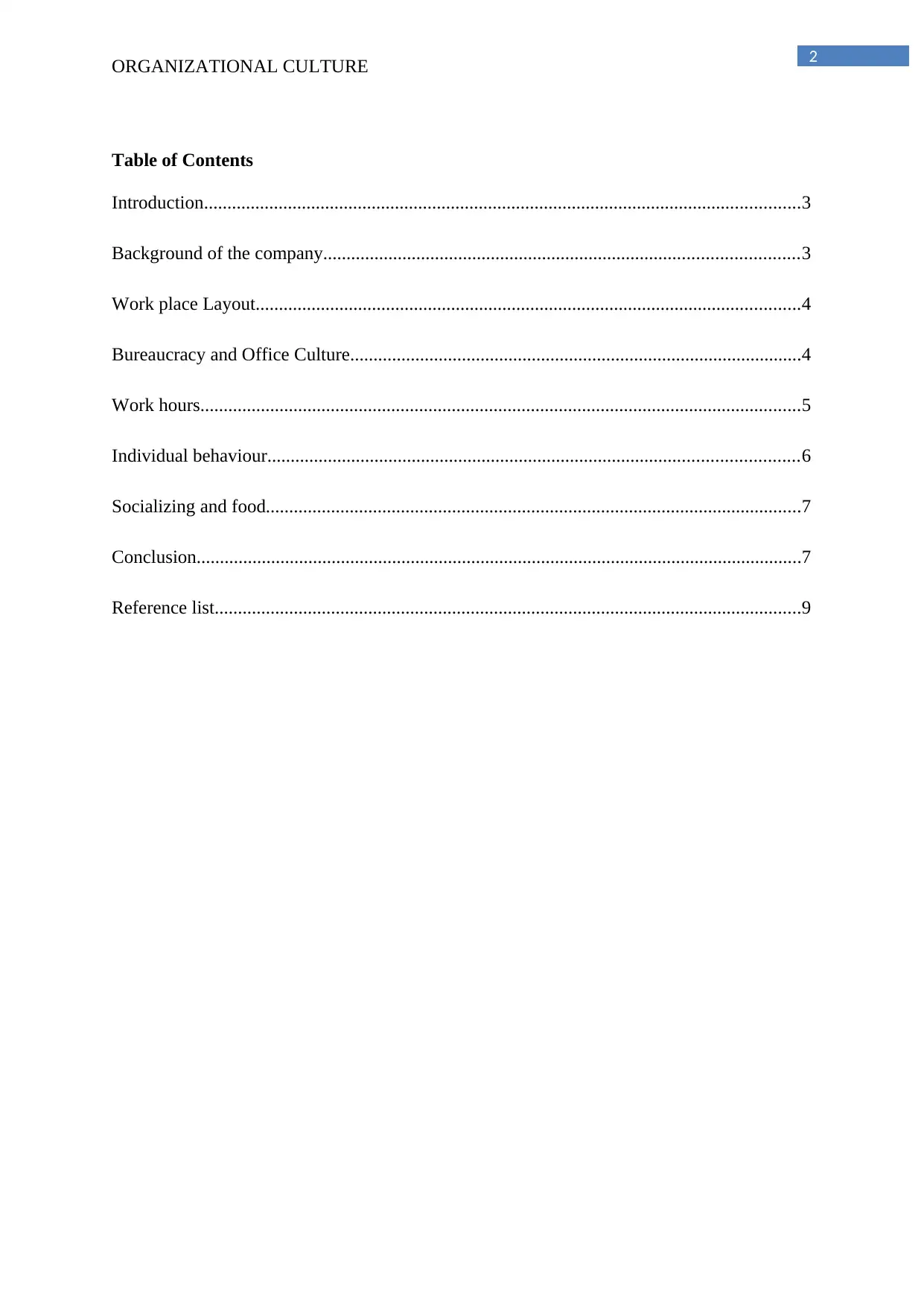
2
ORGANIZATIONAL CULTURE
Table of Contents
Introduction................................................................................................................................3
Background of the company......................................................................................................3
Work place Layout.....................................................................................................................4
Bureaucracy and Office Culture.................................................................................................4
Work hours.................................................................................................................................5
Individual behaviour..................................................................................................................6
Socializing and food...................................................................................................................7
Conclusion..................................................................................................................................7
Reference list..............................................................................................................................9
ORGANIZATIONAL CULTURE
Table of Contents
Introduction................................................................................................................................3
Background of the company......................................................................................................3
Work place Layout.....................................................................................................................4
Bureaucracy and Office Culture.................................................................................................4
Work hours.................................................................................................................................5
Individual behaviour..................................................................................................................6
Socializing and food...................................................................................................................7
Conclusion..................................................................................................................................7
Reference list..............................................................................................................................9
⊘ This is a preview!⊘
Do you want full access?
Subscribe today to unlock all pages.

Trusted by 1+ million students worldwide
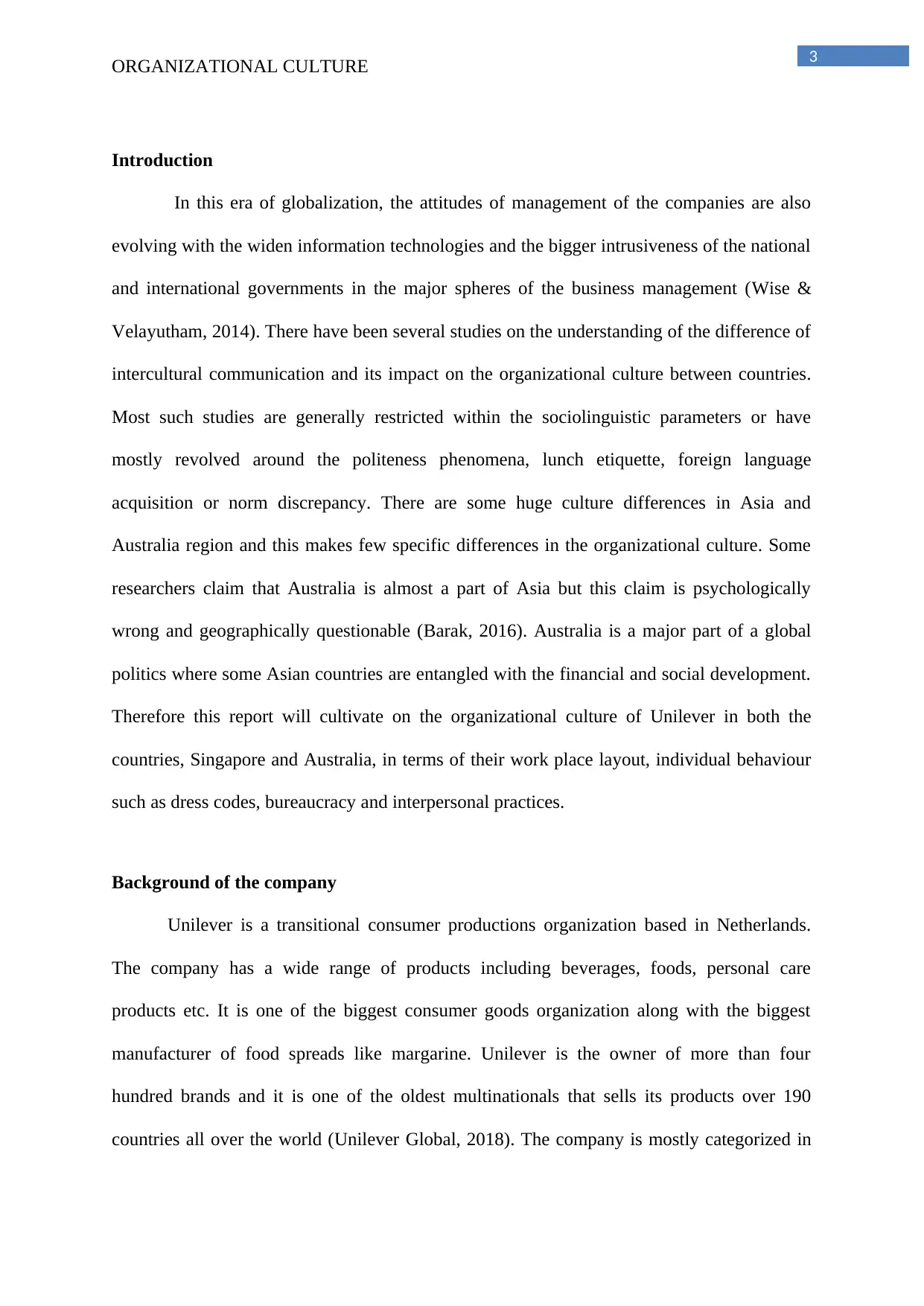
3
ORGANIZATIONAL CULTURE
Introduction
In this era of globalization, the attitudes of management of the companies are also
evolving with the widen information technologies and the bigger intrusiveness of the national
and international governments in the major spheres of the business management (Wise &
Velayutham, 2014). There have been several studies on the understanding of the difference of
intercultural communication and its impact on the organizational culture between countries.
Most such studies are generally restricted within the sociolinguistic parameters or have
mostly revolved around the politeness phenomena, lunch etiquette, foreign language
acquisition or norm discrepancy. There are some huge culture differences in Asia and
Australia region and this makes few specific differences in the organizational culture. Some
researchers claim that Australia is almost a part of Asia but this claim is psychologically
wrong and geographically questionable (Barak, 2016). Australia is a major part of a global
politics where some Asian countries are entangled with the financial and social development.
Therefore this report will cultivate on the organizational culture of Unilever in both the
countries, Singapore and Australia, in terms of their work place layout, individual behaviour
such as dress codes, bureaucracy and interpersonal practices.
Background of the company
Unilever is a transitional consumer productions organization based in Netherlands.
The company has a wide range of products including beverages, foods, personal care
products etc. It is one of the biggest consumer goods organization along with the biggest
manufacturer of food spreads like margarine. Unilever is the owner of more than four
hundred brands and it is one of the oldest multinationals that sells its products over 190
countries all over the world (Unilever Global, 2018). The company is mostly categorized in
ORGANIZATIONAL CULTURE
Introduction
In this era of globalization, the attitudes of management of the companies are also
evolving with the widen information technologies and the bigger intrusiveness of the national
and international governments in the major spheres of the business management (Wise &
Velayutham, 2014). There have been several studies on the understanding of the difference of
intercultural communication and its impact on the organizational culture between countries.
Most such studies are generally restricted within the sociolinguistic parameters or have
mostly revolved around the politeness phenomena, lunch etiquette, foreign language
acquisition or norm discrepancy. There are some huge culture differences in Asia and
Australia region and this makes few specific differences in the organizational culture. Some
researchers claim that Australia is almost a part of Asia but this claim is psychologically
wrong and geographically questionable (Barak, 2016). Australia is a major part of a global
politics where some Asian countries are entangled with the financial and social development.
Therefore this report will cultivate on the organizational culture of Unilever in both the
countries, Singapore and Australia, in terms of their work place layout, individual behaviour
such as dress codes, bureaucracy and interpersonal practices.
Background of the company
Unilever is a transitional consumer productions organization based in Netherlands.
The company has a wide range of products including beverages, foods, personal care
products etc. It is one of the biggest consumer goods organization along with the biggest
manufacturer of food spreads like margarine. Unilever is the owner of more than four
hundred brands and it is one of the oldest multinationals that sells its products over 190
countries all over the world (Unilever Global, 2018). The company is mostly categorized in
Paraphrase This Document
Need a fresh take? Get an instant paraphrase of this document with our AI Paraphraser
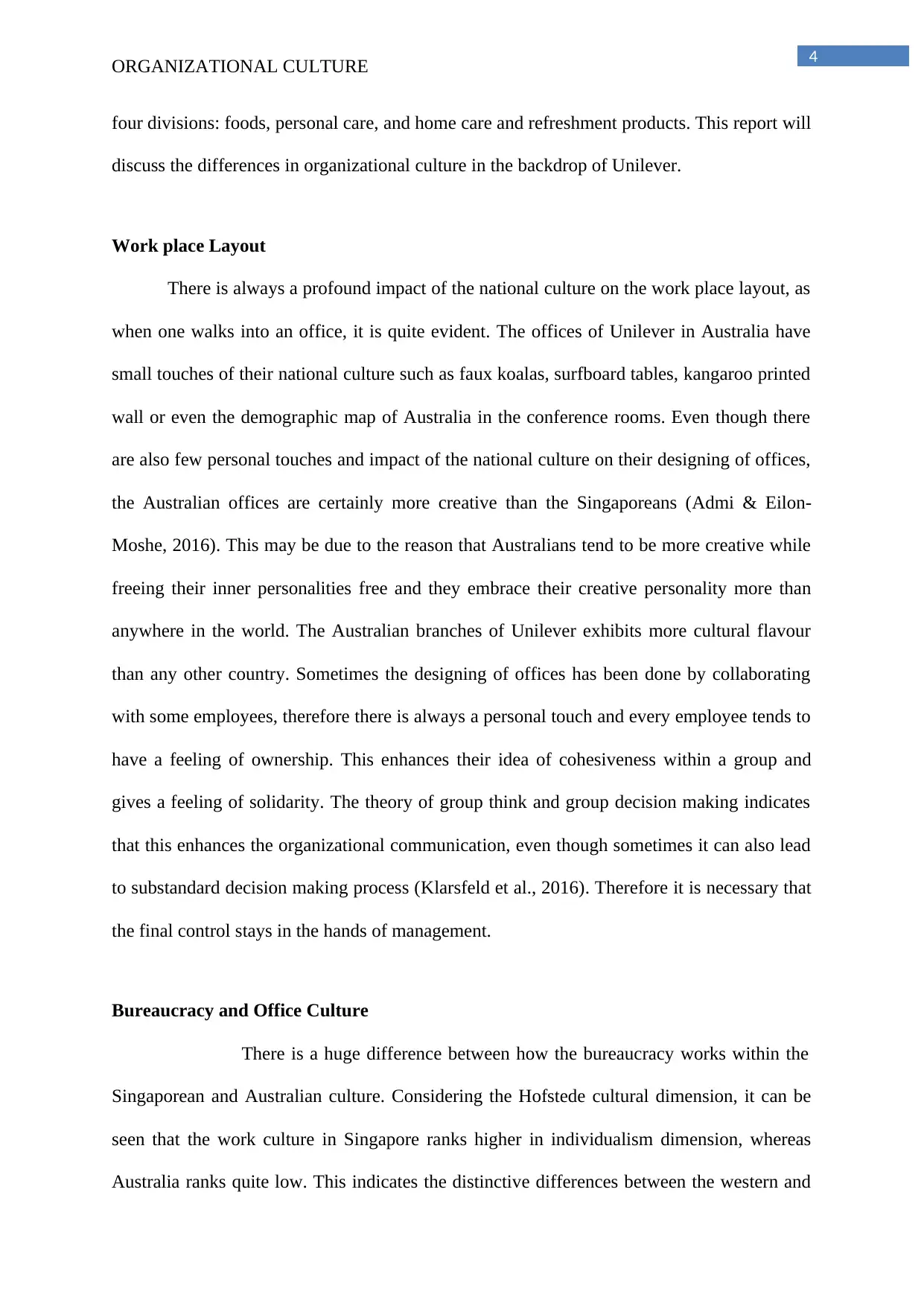
4
ORGANIZATIONAL CULTURE
four divisions: foods, personal care, and home care and refreshment products. This report will
discuss the differences in organizational culture in the backdrop of Unilever.
Work place Layout
There is always a profound impact of the national culture on the work place layout, as
when one walks into an office, it is quite evident. The offices of Unilever in Australia have
small touches of their national culture such as faux koalas, surfboard tables, kangaroo printed
wall or even the demographic map of Australia in the conference rooms. Even though there
are also few personal touches and impact of the national culture on their designing of offices,
the Australian offices are certainly more creative than the Singaporeans (Admi & Eilon-
Moshe, 2016). This may be due to the reason that Australians tend to be more creative while
freeing their inner personalities free and they embrace their creative personality more than
anywhere in the world. The Australian branches of Unilever exhibits more cultural flavour
than any other country. Sometimes the designing of offices has been done by collaborating
with some employees, therefore there is always a personal touch and every employee tends to
have a feeling of ownership. This enhances their idea of cohesiveness within a group and
gives a feeling of solidarity. The theory of group think and group decision making indicates
that this enhances the organizational communication, even though sometimes it can also lead
to substandard decision making process (Klarsfeld et al., 2016). Therefore it is necessary that
the final control stays in the hands of management.
Bureaucracy and Office Culture
There is a huge difference between how the bureaucracy works within the
Singaporean and Australian culture. Considering the Hofstede cultural dimension, it can be
seen that the work culture in Singapore ranks higher in individualism dimension, whereas
Australia ranks quite low. This indicates the distinctive differences between the western and
ORGANIZATIONAL CULTURE
four divisions: foods, personal care, and home care and refreshment products. This report will
discuss the differences in organizational culture in the backdrop of Unilever.
Work place Layout
There is always a profound impact of the national culture on the work place layout, as
when one walks into an office, it is quite evident. The offices of Unilever in Australia have
small touches of their national culture such as faux koalas, surfboard tables, kangaroo printed
wall or even the demographic map of Australia in the conference rooms. Even though there
are also few personal touches and impact of the national culture on their designing of offices,
the Australian offices are certainly more creative than the Singaporeans (Admi & Eilon-
Moshe, 2016). This may be due to the reason that Australians tend to be more creative while
freeing their inner personalities free and they embrace their creative personality more than
anywhere in the world. The Australian branches of Unilever exhibits more cultural flavour
than any other country. Sometimes the designing of offices has been done by collaborating
with some employees, therefore there is always a personal touch and every employee tends to
have a feeling of ownership. This enhances their idea of cohesiveness within a group and
gives a feeling of solidarity. The theory of group think and group decision making indicates
that this enhances the organizational communication, even though sometimes it can also lead
to substandard decision making process (Klarsfeld et al., 2016). Therefore it is necessary that
the final control stays in the hands of management.
Bureaucracy and Office Culture
There is a huge difference between how the bureaucracy works within the
Singaporean and Australian culture. Considering the Hofstede cultural dimension, it can be
seen that the work culture in Singapore ranks higher in individualism dimension, whereas
Australia ranks quite low. This indicates the distinctive differences between the western and
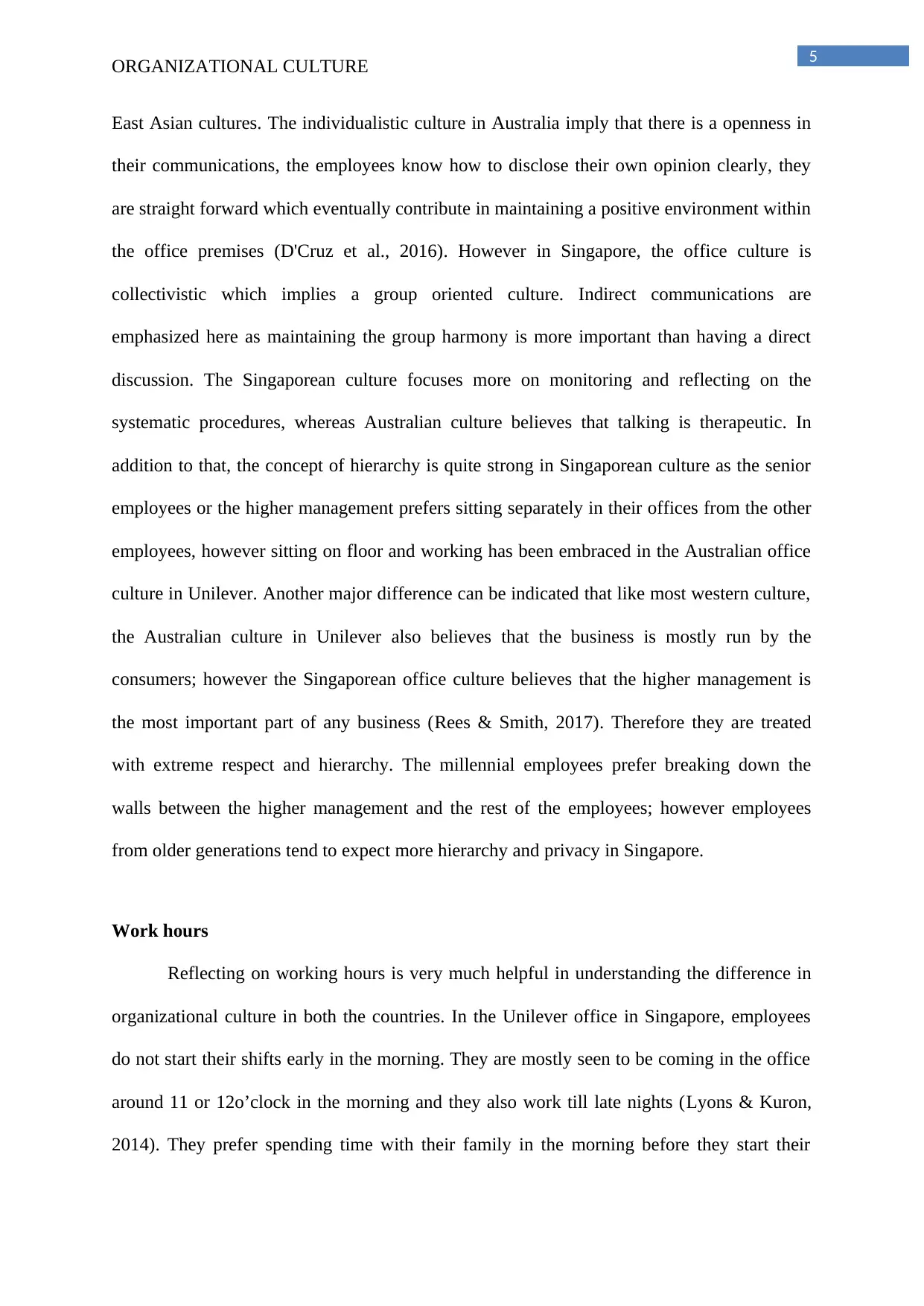
5
ORGANIZATIONAL CULTURE
East Asian cultures. The individualistic culture in Australia imply that there is a openness in
their communications, the employees know how to disclose their own opinion clearly, they
are straight forward which eventually contribute in maintaining a positive environment within
the office premises (D'Cruz et al., 2016). However in Singapore, the office culture is
collectivistic which implies a group oriented culture. Indirect communications are
emphasized here as maintaining the group harmony is more important than having a direct
discussion. The Singaporean culture focuses more on monitoring and reflecting on the
systematic procedures, whereas Australian culture believes that talking is therapeutic. In
addition to that, the concept of hierarchy is quite strong in Singaporean culture as the senior
employees or the higher management prefers sitting separately in their offices from the other
employees, however sitting on floor and working has been embraced in the Australian office
culture in Unilever. Another major difference can be indicated that like most western culture,
the Australian culture in Unilever also believes that the business is mostly run by the
consumers; however the Singaporean office culture believes that the higher management is
the most important part of any business (Rees & Smith, 2017). Therefore they are treated
with extreme respect and hierarchy. The millennial employees prefer breaking down the
walls between the higher management and the rest of the employees; however employees
from older generations tend to expect more hierarchy and privacy in Singapore.
Work hours
Reflecting on working hours is very much helpful in understanding the difference in
organizational culture in both the countries. In the Unilever office in Singapore, employees
do not start their shifts early in the morning. They are mostly seen to be coming in the office
around 11 or 12o’clock in the morning and they also work till late nights (Lyons & Kuron,
2014). They prefer spending time with their family in the morning before they start their
ORGANIZATIONAL CULTURE
East Asian cultures. The individualistic culture in Australia imply that there is a openness in
their communications, the employees know how to disclose their own opinion clearly, they
are straight forward which eventually contribute in maintaining a positive environment within
the office premises (D'Cruz et al., 2016). However in Singapore, the office culture is
collectivistic which implies a group oriented culture. Indirect communications are
emphasized here as maintaining the group harmony is more important than having a direct
discussion. The Singaporean culture focuses more on monitoring and reflecting on the
systematic procedures, whereas Australian culture believes that talking is therapeutic. In
addition to that, the concept of hierarchy is quite strong in Singaporean culture as the senior
employees or the higher management prefers sitting separately in their offices from the other
employees, however sitting on floor and working has been embraced in the Australian office
culture in Unilever. Another major difference can be indicated that like most western culture,
the Australian culture in Unilever also believes that the business is mostly run by the
consumers; however the Singaporean office culture believes that the higher management is
the most important part of any business (Rees & Smith, 2017). Therefore they are treated
with extreme respect and hierarchy. The millennial employees prefer breaking down the
walls between the higher management and the rest of the employees; however employees
from older generations tend to expect more hierarchy and privacy in Singapore.
Work hours
Reflecting on working hours is very much helpful in understanding the difference in
organizational culture in both the countries. In the Unilever office in Singapore, employees
do not start their shifts early in the morning. They are mostly seen to be coming in the office
around 11 or 12o’clock in the morning and they also work till late nights (Lyons & Kuron,
2014). They prefer spending time with their family in the morning before they start their
⊘ This is a preview!⊘
Do you want full access?
Subscribe today to unlock all pages.

Trusted by 1+ million students worldwide
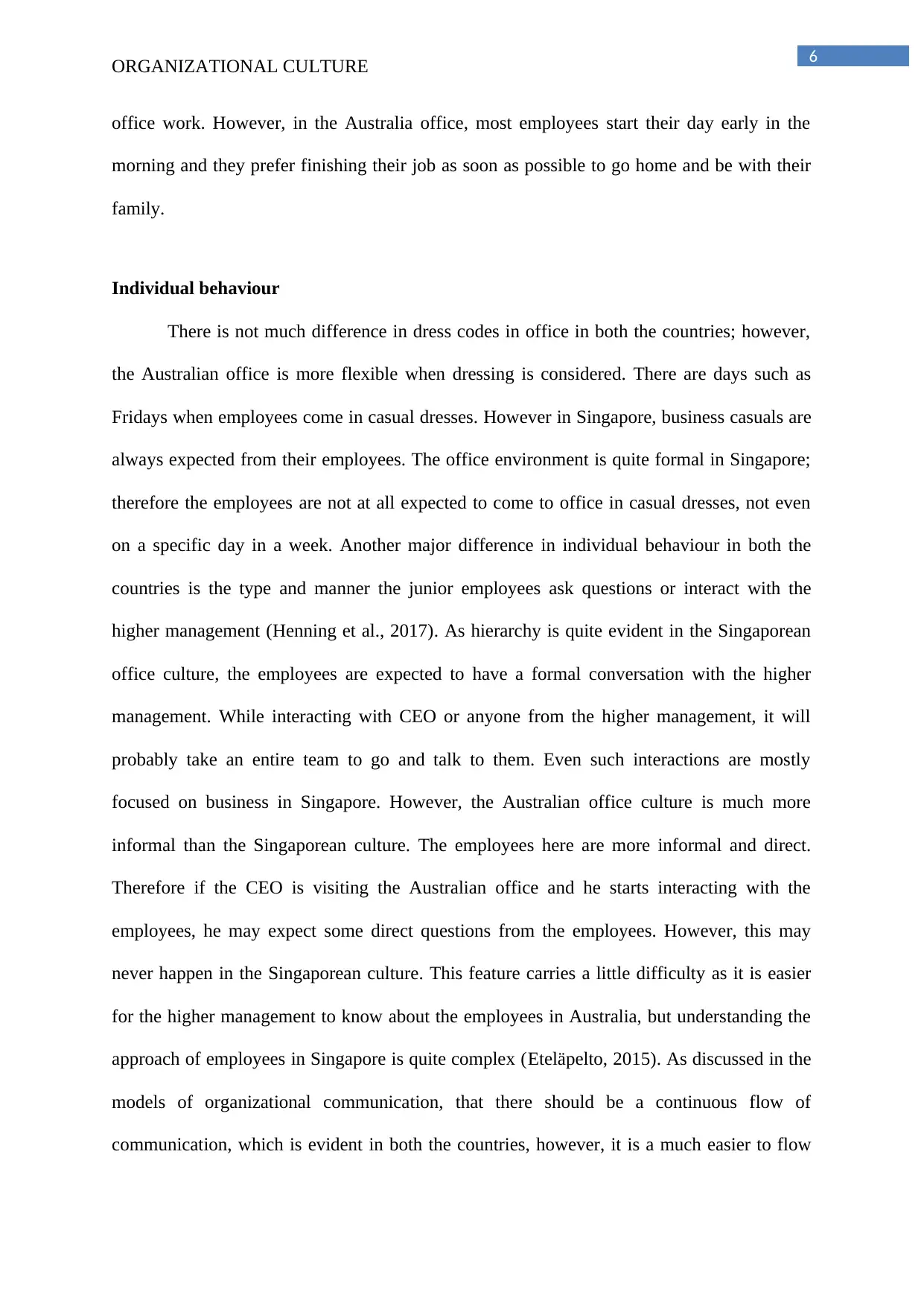
6
ORGANIZATIONAL CULTURE
office work. However, in the Australia office, most employees start their day early in the
morning and they prefer finishing their job as soon as possible to go home and be with their
family.
Individual behaviour
There is not much difference in dress codes in office in both the countries; however,
the Australian office is more flexible when dressing is considered. There are days such as
Fridays when employees come in casual dresses. However in Singapore, business casuals are
always expected from their employees. The office environment is quite formal in Singapore;
therefore the employees are not at all expected to come to office in casual dresses, not even
on a specific day in a week. Another major difference in individual behaviour in both the
countries is the type and manner the junior employees ask questions or interact with the
higher management (Henning et al., 2017). As hierarchy is quite evident in the Singaporean
office culture, the employees are expected to have a formal conversation with the higher
management. While interacting with CEO or anyone from the higher management, it will
probably take an entire team to go and talk to them. Even such interactions are mostly
focused on business in Singapore. However, the Australian office culture is much more
informal than the Singaporean culture. The employees here are more informal and direct.
Therefore if the CEO is visiting the Australian office and he starts interacting with the
employees, he may expect some direct questions from the employees. However, this may
never happen in the Singaporean culture. This feature carries a little difficulty as it is easier
for the higher management to know about the employees in Australia, but understanding the
approach of employees in Singapore is quite complex (Eteläpelto, 2015). As discussed in the
models of organizational communication, that there should be a continuous flow of
communication, which is evident in both the countries, however, it is a much easier to flow
ORGANIZATIONAL CULTURE
office work. However, in the Australia office, most employees start their day early in the
morning and they prefer finishing their job as soon as possible to go home and be with their
family.
Individual behaviour
There is not much difference in dress codes in office in both the countries; however,
the Australian office is more flexible when dressing is considered. There are days such as
Fridays when employees come in casual dresses. However in Singapore, business casuals are
always expected from their employees. The office environment is quite formal in Singapore;
therefore the employees are not at all expected to come to office in casual dresses, not even
on a specific day in a week. Another major difference in individual behaviour in both the
countries is the type and manner the junior employees ask questions or interact with the
higher management (Henning et al., 2017). As hierarchy is quite evident in the Singaporean
office culture, the employees are expected to have a formal conversation with the higher
management. While interacting with CEO or anyone from the higher management, it will
probably take an entire team to go and talk to them. Even such interactions are mostly
focused on business in Singapore. However, the Australian office culture is much more
informal than the Singaporean culture. The employees here are more informal and direct.
Therefore if the CEO is visiting the Australian office and he starts interacting with the
employees, he may expect some direct questions from the employees. However, this may
never happen in the Singaporean culture. This feature carries a little difficulty as it is easier
for the higher management to know about the employees in Australia, but understanding the
approach of employees in Singapore is quite complex (Eteläpelto, 2015). As discussed in the
models of organizational communication, that there should be a continuous flow of
communication, which is evident in both the countries, however, it is a much easier to flow
Paraphrase This Document
Need a fresh take? Get an instant paraphrase of this document with our AI Paraphraser
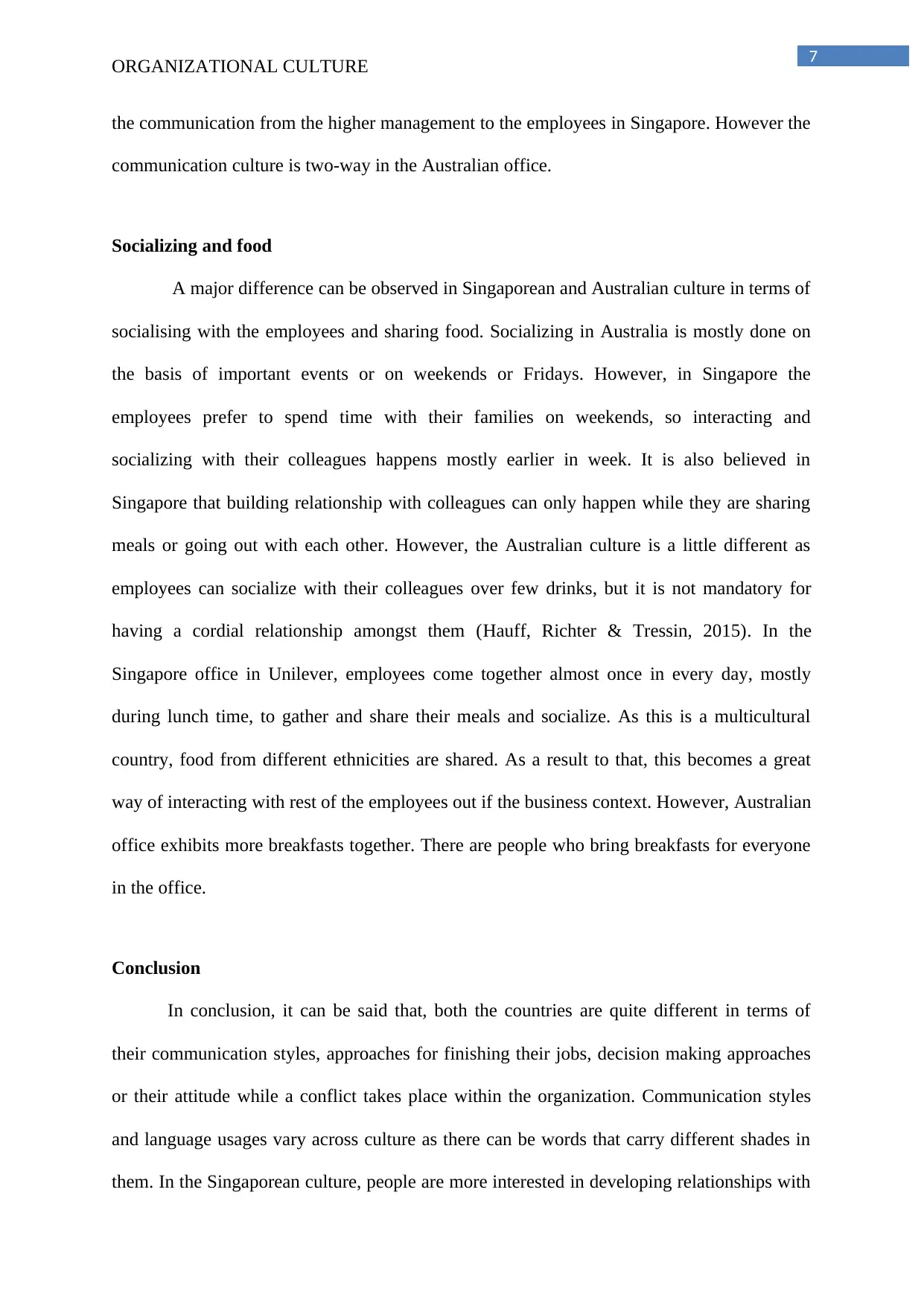
7
ORGANIZATIONAL CULTURE
the communication from the higher management to the employees in Singapore. However the
communication culture is two-way in the Australian office.
Socializing and food
A major difference can be observed in Singaporean and Australian culture in terms of
socialising with the employees and sharing food. Socializing in Australia is mostly done on
the basis of important events or on weekends or Fridays. However, in Singapore the
employees prefer to spend time with their families on weekends, so interacting and
socializing with their colleagues happens mostly earlier in week. It is also believed in
Singapore that building relationship with colleagues can only happen while they are sharing
meals or going out with each other. However, the Australian culture is a little different as
employees can socialize with their colleagues over few drinks, but it is not mandatory for
having a cordial relationship amongst them (Hauff, Richter & Tressin, 2015). In the
Singapore office in Unilever, employees come together almost once in every day, mostly
during lunch time, to gather and share their meals and socialize. As this is a multicultural
country, food from different ethnicities are shared. As a result to that, this becomes a great
way of interacting with rest of the employees out if the business context. However, Australian
office exhibits more breakfasts together. There are people who bring breakfasts for everyone
in the office.
Conclusion
In conclusion, it can be said that, both the countries are quite different in terms of
their communication styles, approaches for finishing their jobs, decision making approaches
or their attitude while a conflict takes place within the organization. Communication styles
and language usages vary across culture as there can be words that carry different shades in
them. In the Singaporean culture, people are more interested in developing relationships with
ORGANIZATIONAL CULTURE
the communication from the higher management to the employees in Singapore. However the
communication culture is two-way in the Australian office.
Socializing and food
A major difference can be observed in Singaporean and Australian culture in terms of
socialising with the employees and sharing food. Socializing in Australia is mostly done on
the basis of important events or on weekends or Fridays. However, in Singapore the
employees prefer to spend time with their families on weekends, so interacting and
socializing with their colleagues happens mostly earlier in week. It is also believed in
Singapore that building relationship with colleagues can only happen while they are sharing
meals or going out with each other. However, the Australian culture is a little different as
employees can socialize with their colleagues over few drinks, but it is not mandatory for
having a cordial relationship amongst them (Hauff, Richter & Tressin, 2015). In the
Singapore office in Unilever, employees come together almost once in every day, mostly
during lunch time, to gather and share their meals and socialize. As this is a multicultural
country, food from different ethnicities are shared. As a result to that, this becomes a great
way of interacting with rest of the employees out if the business context. However, Australian
office exhibits more breakfasts together. There are people who bring breakfasts for everyone
in the office.
Conclusion
In conclusion, it can be said that, both the countries are quite different in terms of
their communication styles, approaches for finishing their jobs, decision making approaches
or their attitude while a conflict takes place within the organization. Communication styles
and language usages vary across culture as there can be words that carry different shades in
them. In the Singaporean culture, people are more interested in developing relationships with
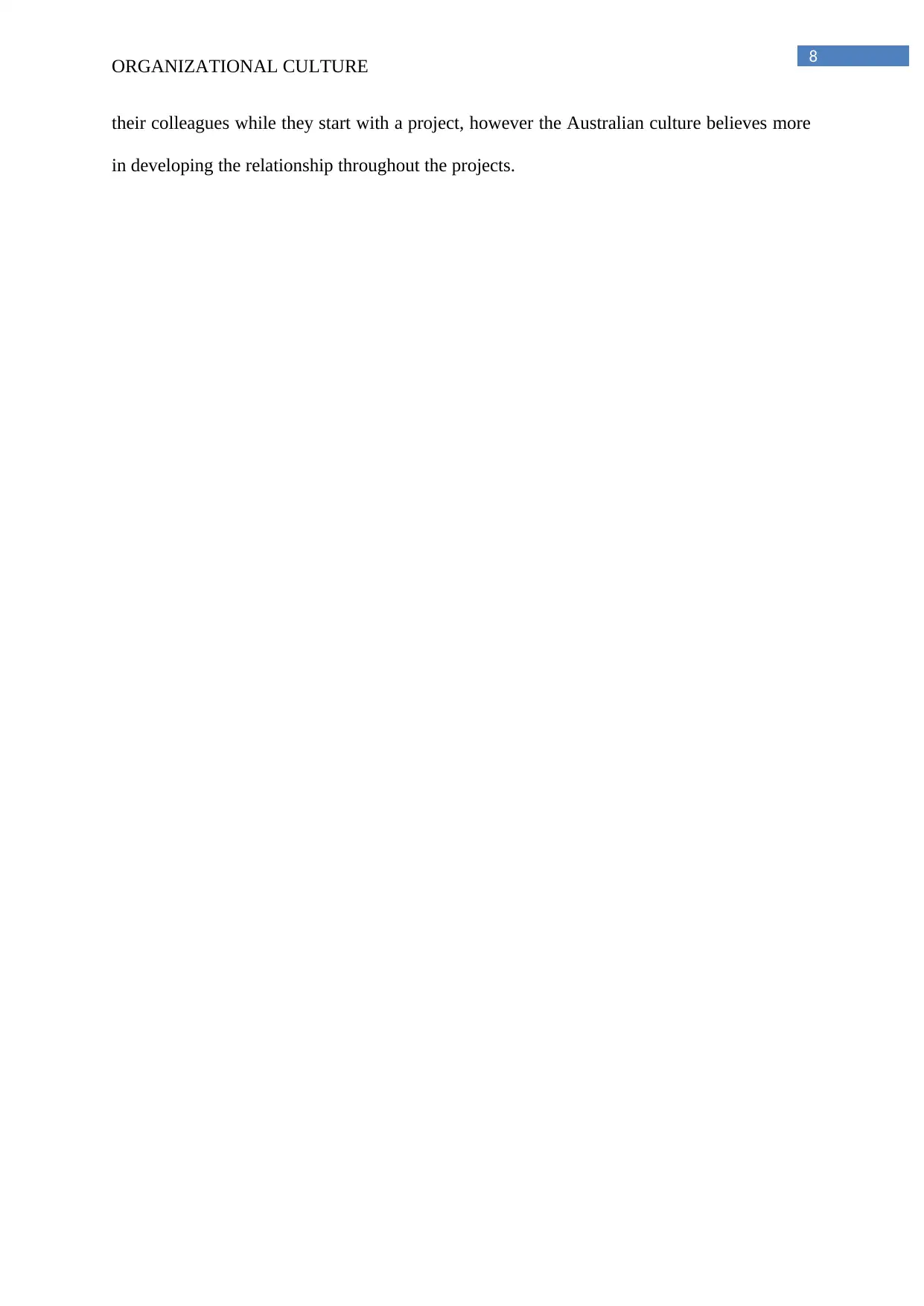
8
ORGANIZATIONAL CULTURE
their colleagues while they start with a project, however the Australian culture believes more
in developing the relationship throughout the projects.
ORGANIZATIONAL CULTURE
their colleagues while they start with a project, however the Australian culture believes more
in developing the relationship throughout the projects.
⊘ This is a preview!⊘
Do you want full access?
Subscribe today to unlock all pages.

Trusted by 1+ million students worldwide
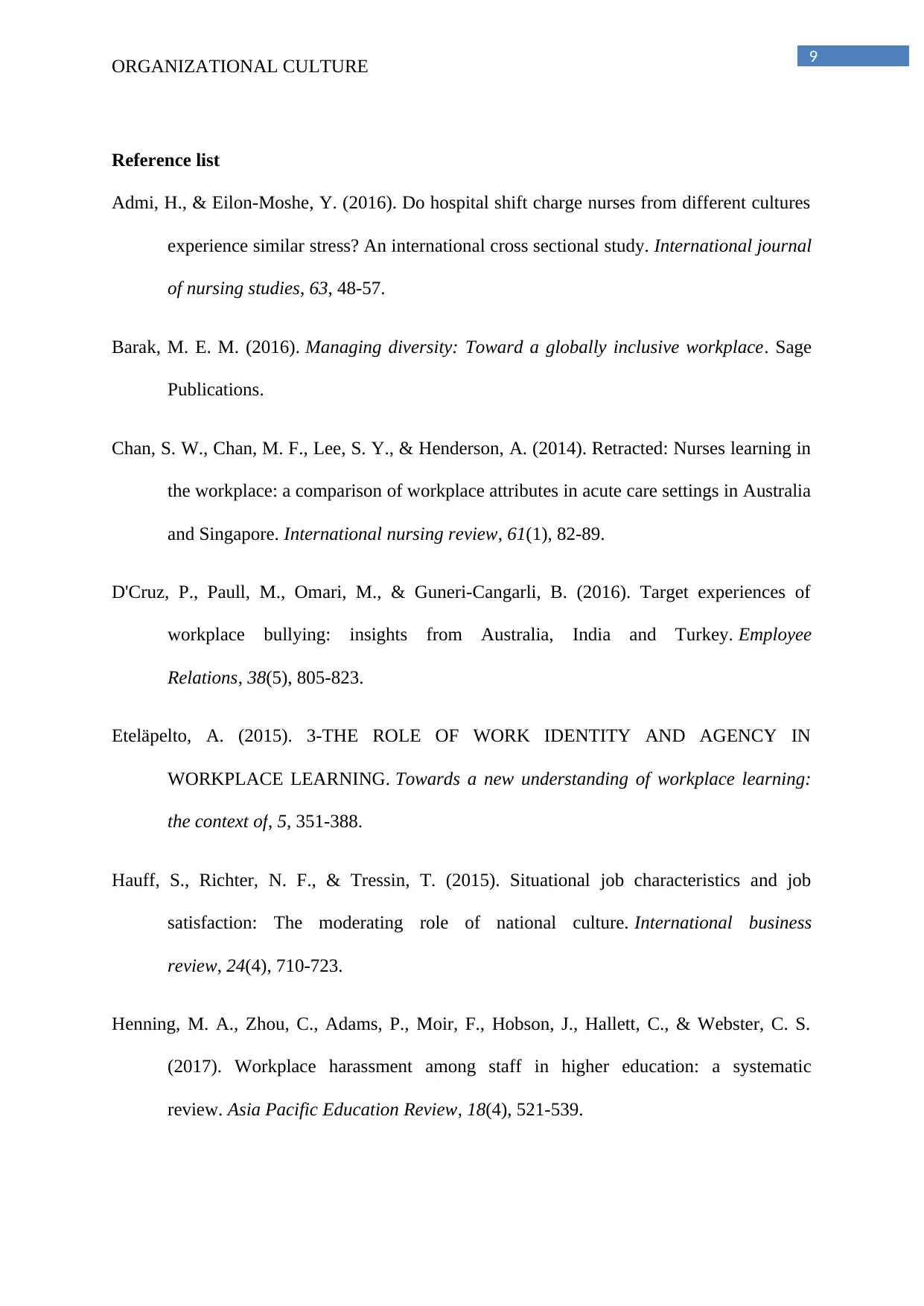
9
ORGANIZATIONAL CULTURE
Reference list
Admi, H., & Eilon-Moshe, Y. (2016). Do hospital shift charge nurses from different cultures
experience similar stress? An international cross sectional study. International journal
of nursing studies, 63, 48-57.
Barak, M. E. M. (2016). Managing diversity: Toward a globally inclusive workplace. Sage
Publications.
Chan, S. W., Chan, M. F., Lee, S. Y., & Henderson, A. (2014). Retracted: Nurses learning in
the workplace: a comparison of workplace attributes in acute care settings in Australia
and Singapore. International nursing review, 61(1), 82-89.
D'Cruz, P., Paull, M., Omari, M., & Guneri-Cangarli, B. (2016). Target experiences of
workplace bullying: insights from Australia, India and Turkey. Employee
Relations, 38(5), 805-823.
Eteläpelto, A. (2015). 3-THE ROLE OF WORK IDENTITY AND AGENCY IN
WORKPLACE LEARNING. Towards a new understanding of workplace learning:
the context of, 5, 351-388.
Hauff, S., Richter, N. F., & Tressin, T. (2015). Situational job characteristics and job
satisfaction: The moderating role of national culture. International business
review, 24(4), 710-723.
Henning, M. A., Zhou, C., Adams, P., Moir, F., Hobson, J., Hallett, C., & Webster, C. S.
(2017). Workplace harassment among staff in higher education: a systematic
review. Asia Pacific Education Review, 18(4), 521-539.
ORGANIZATIONAL CULTURE
Reference list
Admi, H., & Eilon-Moshe, Y. (2016). Do hospital shift charge nurses from different cultures
experience similar stress? An international cross sectional study. International journal
of nursing studies, 63, 48-57.
Barak, M. E. M. (2016). Managing diversity: Toward a globally inclusive workplace. Sage
Publications.
Chan, S. W., Chan, M. F., Lee, S. Y., & Henderson, A. (2014). Retracted: Nurses learning in
the workplace: a comparison of workplace attributes in acute care settings in Australia
and Singapore. International nursing review, 61(1), 82-89.
D'Cruz, P., Paull, M., Omari, M., & Guneri-Cangarli, B. (2016). Target experiences of
workplace bullying: insights from Australia, India and Turkey. Employee
Relations, 38(5), 805-823.
Eteläpelto, A. (2015). 3-THE ROLE OF WORK IDENTITY AND AGENCY IN
WORKPLACE LEARNING. Towards a new understanding of workplace learning:
the context of, 5, 351-388.
Hauff, S., Richter, N. F., & Tressin, T. (2015). Situational job characteristics and job
satisfaction: The moderating role of national culture. International business
review, 24(4), 710-723.
Henning, M. A., Zhou, C., Adams, P., Moir, F., Hobson, J., Hallett, C., & Webster, C. S.
(2017). Workplace harassment among staff in higher education: a systematic
review. Asia Pacific Education Review, 18(4), 521-539.
Paraphrase This Document
Need a fresh take? Get an instant paraphrase of this document with our AI Paraphraser
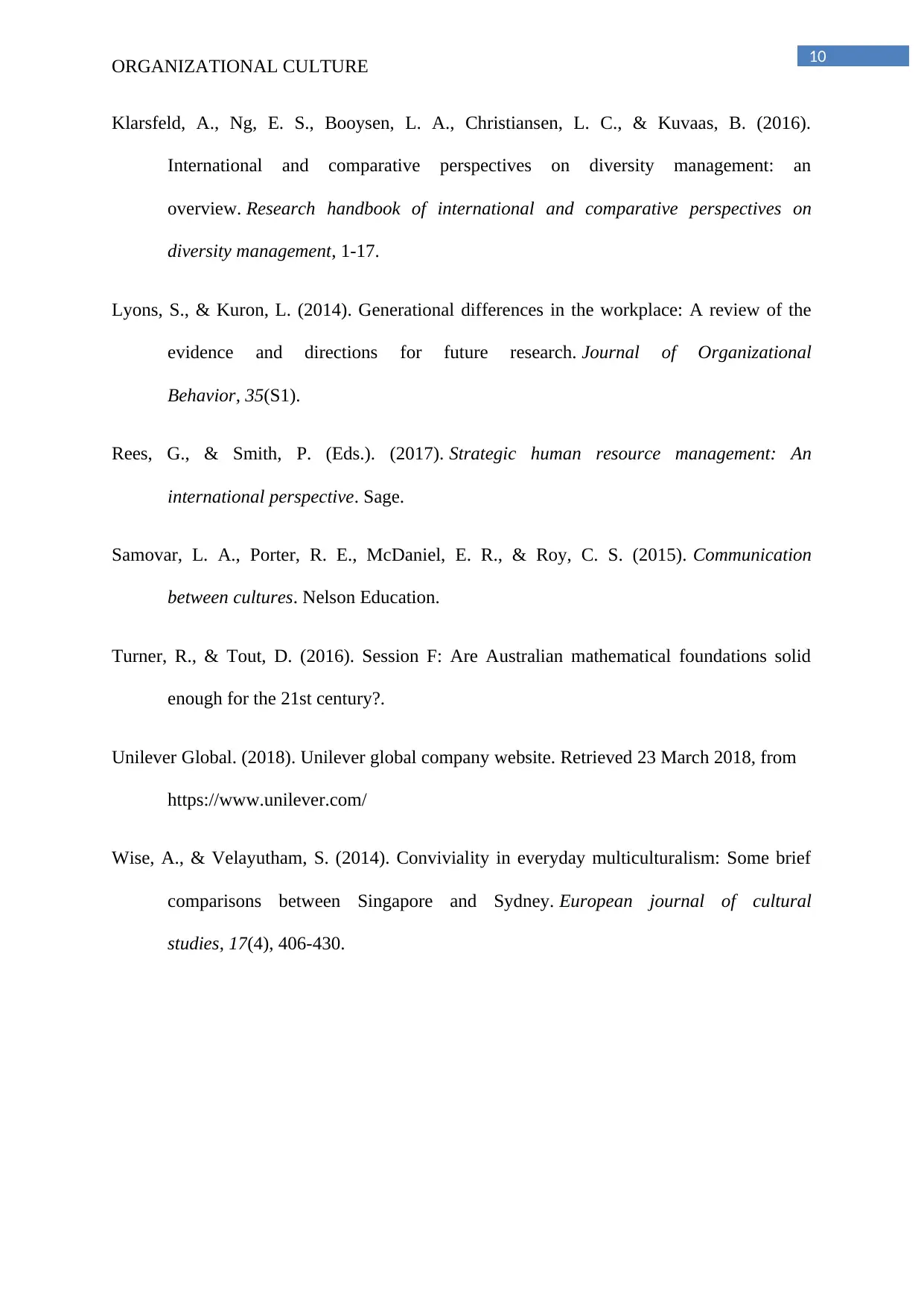
10
ORGANIZATIONAL CULTURE
Klarsfeld, A., Ng, E. S., Booysen, L. A., Christiansen, L. C., & Kuvaas, B. (2016).
International and comparative perspectives on diversity management: an
overview. Research handbook of international and comparative perspectives on
diversity management, 1-17.
Lyons, S., & Kuron, L. (2014). Generational differences in the workplace: A review of the
evidence and directions for future research. Journal of Organizational
Behavior, 35(S1).
Rees, G., & Smith, P. (Eds.). (2017). Strategic human resource management: An
international perspective. Sage.
Samovar, L. A., Porter, R. E., McDaniel, E. R., & Roy, C. S. (2015). Communication
between cultures. Nelson Education.
Turner, R., & Tout, D. (2016). Session F: Are Australian mathematical foundations solid
enough for the 21st century?.
Unilever Global. (2018). Unilever global company website. Retrieved 23 March 2018, from
https://www.unilever.com/
Wise, A., & Velayutham, S. (2014). Conviviality in everyday multiculturalism: Some brief
comparisons between Singapore and Sydney. European journal of cultural
studies, 17(4), 406-430.
ORGANIZATIONAL CULTURE
Klarsfeld, A., Ng, E. S., Booysen, L. A., Christiansen, L. C., & Kuvaas, B. (2016).
International and comparative perspectives on diversity management: an
overview. Research handbook of international and comparative perspectives on
diversity management, 1-17.
Lyons, S., & Kuron, L. (2014). Generational differences in the workplace: A review of the
evidence and directions for future research. Journal of Organizational
Behavior, 35(S1).
Rees, G., & Smith, P. (Eds.). (2017). Strategic human resource management: An
international perspective. Sage.
Samovar, L. A., Porter, R. E., McDaniel, E. R., & Roy, C. S. (2015). Communication
between cultures. Nelson Education.
Turner, R., & Tout, D. (2016). Session F: Are Australian mathematical foundations solid
enough for the 21st century?.
Unilever Global. (2018). Unilever global company website. Retrieved 23 March 2018, from
https://www.unilever.com/
Wise, A., & Velayutham, S. (2014). Conviviality in everyday multiculturalism: Some brief
comparisons between Singapore and Sydney. European journal of cultural
studies, 17(4), 406-430.
1 out of 11
Related Documents
Your All-in-One AI-Powered Toolkit for Academic Success.
+13062052269
info@desklib.com
Available 24*7 on WhatsApp / Email
![[object Object]](/_next/static/media/star-bottom.7253800d.svg)
Unlock your academic potential
Copyright © 2020–2025 A2Z Services. All Rights Reserved. Developed and managed by ZUCOL.



